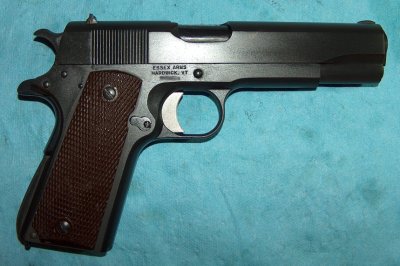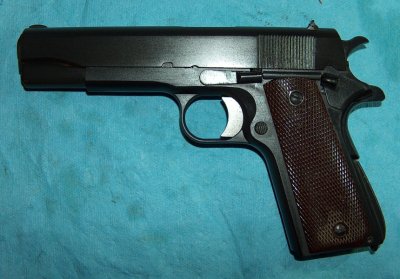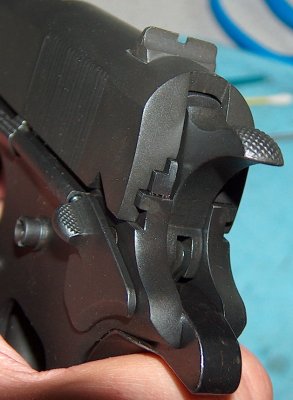A Million Little Pieces
I've Been Framed
Guts and Glory
Pins and Needle Files
My Luggy Day
Searious Issues
Sliding Into Position
All Together Now
Spacing Out
Wear to Go from Here
Barreling Ahead
Breech of the Piece
Starting Out with a Bang
Round Two (hundred)
The Kart of Barrel Fitting
Fed Up
Safety is a Snap
Dispatches from the Front
Pulling Through
The Final Part
Lessons Learned
Frequently Asked Questions
Errata and Clarifications
More articles
All Together Now
For the first time since starting this project, I was able to hold the fully-assembled gun in my greasy hands, as well as photograph it lying on a greasy shop towel. The general theme I'm trying to communicate here is one of grease.

Greaseful lines.
If you look closely at the above photo, you'll notice a faint gold-colored streak forward of the ejection port. This is what happens when you forget to remove your wedding band when field-stripping a 1911, and provides a great illustration of who wins when soft and hard metals meet. I'm just glad I don't wear a tungsten ring.

Looking at things from the other side.
Sharp-eyed people may have already spotted it in the above photos, but it wasn't until I held the assembled pistol in my hands that I noticed the rear of the slide sat forward from the rear of the frame.

A forward-thinking slide?
Note the little dimple on the rear of the extractor in the above photo; somebody performed Rockwell hardness testing on the extractor. Of course, I don't know if it passed or failed.
Returning to the matter of the slide/frame mismatch, I'll spare you an account of my tortuous research into what causes this sort of thing and just provide the information. There are three areas that can contribute to a slide that sits forward on the frame:
- The slide
- The barrel
- The frame
- All of the above
Gosh, that sure narrows it down!
The slide is an obvious culprit; in the above photo it just looks like the rear of the slide doesn't come far enough back. Alternately, the lug recesses inside the slide, if located too far to the rear, make the barrel sit farther back relative to the front of the slide; this means the barrel's lower lug is also farther back, so the slide has to sit forward a bit in order to bring the barrel's lower lug into contact with the slide stop.
Of course, if the barrel's upper lugs are too far forward, you get the exact same result as if the slide's lugs are too far to the rear. There's also another gotcha related to the lower lug, especially if a drop-in barrel is used: If the barrel's lower lug is too large, the gun will not go into battery; therefore, drop-in barrels' lower lugs will err on the side of being undersized, and an undersized lower lug moves the entire slide forward until it rests on the slide stop. You could also get the same results if the lower lug is located too far toward the rear of the barrel.
All this talk of things having to move forward to the slide stop ignores the question of whether the slide stop is in the right place. As the slide stop hole moves forward relative to the rear of the frame, so does the slide. There's also the chance (unlikely in my case) that the rear of the frame could be built with a little bit of extra material to permit blending the slide and frame for a really snazzy-looking custom fit.
Finally, it's possible that every single one of the above flaws is present; in fact, each part could be in spec, but if all the measurements that contribute to the location of the slide on the frame fall toward one end of the acceptable range of measurements, the additive result of these discrepencies can be large. This is spec-stacking, the mechanical equivalent of a game of "telephone."
For this particular gun, evidence pointed to a combination of an undersized lower lug on a drop-in barrel and an out-of-spec slide, although I still wonder if the Essex frame is a built slightly long at the end to permit blending.

Note the rear of the ejecter.
In the above photo, the rear of the ejecter sits slightly forward of the rear of the frame; normally, these two should be flush. Although it's possible the ejecter is too short, if the manual safety is engaged and the slide shoved back as far back as the safety allows (to correct for an undersized lower lug on the barrel), the slide only goes back far enough to sit flush with the rear of the ejecter, not with the rear of the frame.
I would later learn that other people who used the slides sold by Sarco also experienced similar problems, and that these problems disappeared when different slides were used.
email: hidi.projects at gmail.com